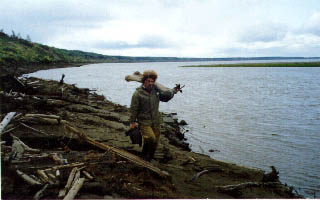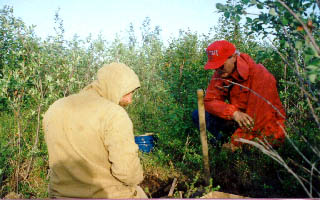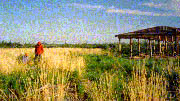The Pleistocene Park Concept
An Illustration
 |
During the Pleistocene,
much of the Siberian north was covered with a steppe grassland which was
the home of millions of bison, mammoths, and other grazing animals. In
the picture at the right, Sergei Zimov, Director of the Northeast Science
Station, carries a mammoth bone found in a deposit near Pleistocene Park.
However, the huge herds of animals have disappeared, and the once-rich
grasslands on which they grazed are now largely dominated by shrubs or
mossy tundras and bogs.
In 1989 Sergei Zimov
initiated a small-scale experiment to attempt to reconvert these areas
to productive grassland by reintroducing grazers. He brought in a
small herd of hardy Yakutian horses, the closest descendants of the Pleistocene
horse which lived in this region, and pastured them in a small paddock
for several weeks. |
Eight years later, the area in which the horses were
pastured is still a fertile grassland, enriched by the presence of grazing
animals.
In these two pictures, we see scientists Jim
Reynolds of Duke University and Sergei Davydov of the Northeast Science
Station making measurements in the thick shrubby area outside the paddock
in which the animals were held, (below, left) and inside the paddock (lower
photo). Soil nutrient availability and plant productivity was greatly increased
within the paddock, as evidenced by the rich growth of grass (below, right).
After several weeks of acclimation in the pens,
the horses were released into the wild. To this day, they or their offspring
can be seen in areas where their grazing activity has increased the abundance
of grasses sufficiently to support them.
Since this experiment, a portion of land has been set aside in the Nizhnekolymskii
Ulus of the Republic of Sakha (Yakutia) for Pleistocene Park. Fences were built
and horses and moose have been introduced into the enclosure.
 |
It is the hope of the supporters of Pleistocene
Park that bison, a key element of the prehistoric
steppe tundra ecosystem, will join the horses, moose, caribou and muskoxen.
Eventually, this park may be a home for the endangered
Siberian tiger, a descendant of the major predator of the prehistoric ecosystem. |
|
|
Back to Northeast Science Station
Back to FS Chapin
Contact web editor Mimi Chapin



